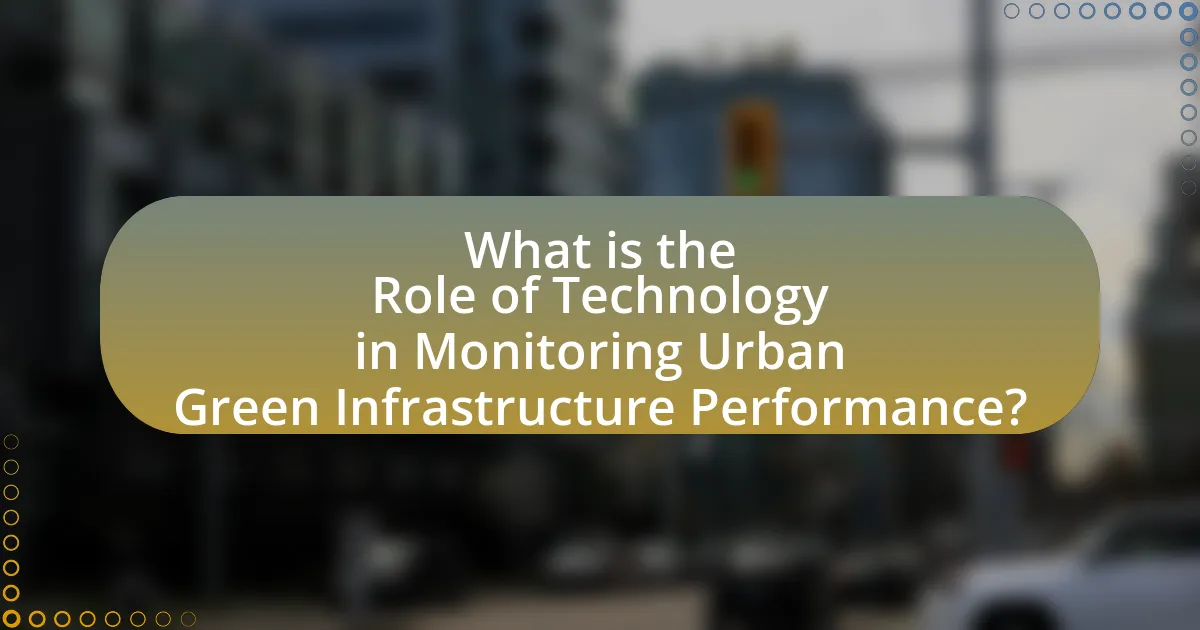The article focuses on the critical role of technology in monitoring urban green infrastructure performance. It highlights various technologies such as remote sensing, Geographic Information Systems (GIS), and Internet of Things (IoT) sensors that facilitate real-time data collection and analysis, enabling cities to assess vegetation health, biodiversity, and environmental conditions. The discussion includes the importance of effective monitoring for urban planning and sustainability, the environmental benefits associated with it, and the challenges faced in integrating these technologies. Additionally, it explores future trends, including advancements in IoT and artificial intelligence, which promise to enhance monitoring accuracy and resource management in urban ecosystems.

What is the Role of Technology in Monitoring Urban Green Infrastructure Performance?
Technology plays a crucial role in monitoring urban green infrastructure performance by providing tools and systems that enable real-time data collection, analysis, and visualization. These technologies, such as remote sensing, geographic information systems (GIS), and IoT sensors, facilitate the assessment of vegetation health, biodiversity, and ecosystem services. For instance, remote sensing can track changes in land cover and vegetation density over time, while IoT sensors can monitor soil moisture and air quality, providing actionable insights for urban planners. Studies have shown that cities utilizing these technologies can improve their green infrastructure management, leading to enhanced sustainability and resilience against climate change impacts.
How does technology facilitate the monitoring of urban green infrastructure?
Technology facilitates the monitoring of urban green infrastructure by utilizing advanced tools such as remote sensing, geographic information systems (GIS), and IoT sensors. These technologies enable real-time data collection and analysis, allowing for precise tracking of vegetation health, biodiversity, and environmental conditions. For instance, satellite imagery can assess canopy cover and vegetation indices, while IoT sensors can monitor soil moisture and temperature, providing critical insights into the performance of green spaces. Studies have shown that integrating these technologies improves urban planning and management, leading to enhanced sustainability and resilience in urban ecosystems.
What types of technologies are commonly used in this monitoring process?
Commonly used technologies in the monitoring process of urban green infrastructure performance include remote sensing, Geographic Information Systems (GIS), and Internet of Things (IoT) devices. Remote sensing utilizes satellite imagery and aerial photography to assess vegetation health and land use changes, providing valuable data for urban planners. GIS integrates spatial data to analyze and visualize the distribution and effectiveness of green spaces, enabling informed decision-making. IoT devices, such as soil moisture sensors and weather stations, collect real-time data on environmental conditions, facilitating adaptive management of green infrastructure. These technologies collectively enhance the understanding and management of urban ecosystems, as evidenced by studies demonstrating improved urban planning outcomes through data-driven approaches.
How do these technologies collect and analyze data?
Technologies collect and analyze data through various methods such as sensors, satellite imagery, and data analytics software. Sensors deployed in urban green infrastructure monitor environmental parameters like temperature, humidity, and soil moisture, providing real-time data. Satellite imagery offers a broader perspective, capturing land use changes and vegetation health over time. Data analytics software processes this information, applying algorithms to identify patterns and trends, which helps in assessing the performance of green infrastructure. For instance, studies have shown that the integration of remote sensing and ground-based data can enhance the accuracy of urban vegetation assessments, demonstrating the effectiveness of these technologies in data collection and analysis.
Why is monitoring urban green infrastructure performance important?
Monitoring urban green infrastructure performance is important because it enables cities to assess the effectiveness of green spaces in providing ecological, social, and economic benefits. Effective monitoring allows for data-driven decision-making, ensuring that urban green areas contribute to improved air quality, biodiversity, and community well-being. For instance, studies have shown that urban trees can reduce air pollution by up to 30%, highlighting the need for ongoing evaluation to maximize these benefits. Additionally, monitoring helps identify areas needing maintenance or improvement, ensuring that investments in green infrastructure yield optimal returns for urban populations.
What environmental benefits are associated with effective monitoring?
Effective monitoring of urban green infrastructure provides several environmental benefits, including enhanced biodiversity, improved air quality, and better water management. By tracking the health and performance of green spaces, cities can identify areas that require intervention, thereby promoting the growth of diverse plant and animal species. Research indicates that urban green areas can reduce air pollutants by up to 30%, significantly improving air quality for residents. Additionally, effective monitoring allows for the optimization of stormwater management, reducing runoff and preventing flooding, which is crucial in urban settings where impervious surfaces dominate. These benefits collectively contribute to healthier urban ecosystems and improved quality of life for city inhabitants.
How does monitoring contribute to urban planning and sustainability?
Monitoring significantly enhances urban planning and sustainability by providing real-time data on environmental conditions, resource usage, and infrastructure performance. This data enables urban planners to make informed decisions that promote efficient land use, reduce waste, and improve the quality of life for residents. For instance, studies show that cities employing smart monitoring systems can reduce energy consumption by up to 30% through optimized resource management. Additionally, monitoring helps identify areas requiring green infrastructure improvements, such as parks and green roofs, which contribute to biodiversity and climate resilience. Thus, effective monitoring is essential for creating sustainable urban environments that adapt to changing conditions and meet the needs of their populations.
What challenges exist in the integration of technology for monitoring?
The challenges in the integration of technology for monitoring urban green infrastructure performance include data interoperability, high costs, and user resistance. Data interoperability issues arise when different technologies and systems cannot effectively communicate or share information, leading to fragmented data that hampers comprehensive analysis. High costs associated with advanced monitoring technologies can limit adoption, particularly for municipalities with constrained budgets. User resistance often stems from a lack of training or understanding of new technologies, which can hinder effective implementation and utilization. These challenges are supported by studies indicating that successful technology integration requires addressing these barriers to enhance monitoring efficiency and effectiveness.
What are the technical limitations of current monitoring technologies?
Current monitoring technologies face several technical limitations, including data accuracy, sensor reliability, and integration challenges. Data accuracy can be compromised due to environmental factors, leading to inconsistent readings; for instance, weather conditions can affect sensor performance, resulting in erroneous data collection. Sensor reliability is another issue, as devices may fail or require frequent maintenance, which can disrupt continuous monitoring. Additionally, integration challenges arise when attempting to combine data from various sources and technologies, often leading to compatibility issues and data silos. These limitations hinder the effectiveness of monitoring urban green infrastructure performance, as highlighted in studies that emphasize the need for improved sensor technology and data management systems to enhance reliability and accuracy in urban monitoring efforts.
How do data privacy and security concerns impact technology use?
Data privacy and security concerns significantly impact technology use by limiting the adoption and implementation of various digital tools and platforms. Organizations often hesitate to utilize advanced technologies, such as IoT devices and data analytics, due to fears of data breaches and non-compliance with regulations like GDPR. For instance, a survey by the International Association of Privacy Professionals found that 70% of companies reported that privacy concerns hindered their ability to innovate. This hesitance can lead to underutilization of technology that could enhance the monitoring and performance of urban green infrastructure, ultimately affecting sustainability efforts and urban planning.
How can technology improve the effectiveness of urban green infrastructure?
Technology can improve the effectiveness of urban green infrastructure by enabling real-time monitoring and data analysis of environmental conditions. For instance, the use of sensors and IoT devices allows cities to track air quality, soil moisture, and temperature, which helps in optimizing the maintenance and performance of green spaces. A study by the University of California found that cities utilizing smart technology for urban forestry management increased tree survival rates by 20% due to timely interventions based on data insights. Additionally, geographic information systems (GIS) can assist in planning and assessing the spatial distribution of green infrastructure, ensuring that resources are allocated efficiently to maximize ecological benefits.
What role does real-time data play in enhancing infrastructure performance?
Real-time data significantly enhances infrastructure performance by providing immediate insights into operational conditions and system status. This immediacy allows for timely decision-making, enabling infrastructure managers to address issues such as maintenance needs, resource allocation, and performance optimization. For instance, a study by the National Institute of Standards and Technology found that real-time monitoring can reduce maintenance costs by up to 30% and improve system reliability. By leveraging real-time data, urban infrastructure can adapt dynamically to changing conditions, ultimately leading to improved efficiency and sustainability.
How can predictive analytics optimize maintenance and resource allocation?
Predictive analytics can optimize maintenance and resource allocation by utilizing historical data and algorithms to forecast equipment failures and resource needs. This approach enables organizations to schedule maintenance proactively, reducing downtime and extending the lifespan of assets. For instance, a study by the International Journal of Production Research found that predictive maintenance can reduce maintenance costs by 25% to 30% and increase equipment availability by 10% to 20%. By analyzing patterns in data, predictive analytics allows for more efficient allocation of resources, ensuring that maintenance activities are performed only when necessary, thus optimizing operational efficiency.
What future trends are emerging in the technology used for monitoring urban green infrastructure?
Future trends in technology for monitoring urban green infrastructure include the increased use of remote sensing, IoT sensors, and AI-driven analytics. Remote sensing technologies, such as satellite imagery and drones, enable comprehensive assessments of vegetation health and land use changes over large areas. IoT sensors provide real-time data on soil moisture, temperature, and air quality, facilitating immediate responses to environmental conditions. AI-driven analytics enhance data interpretation, allowing for predictive modeling and improved decision-making regarding urban green spaces. These advancements are supported by studies indicating that integrating these technologies can lead to more sustainable urban planning and management practices.
How are advancements in IoT shaping the future of urban green monitoring?
Advancements in IoT are significantly enhancing urban green monitoring by enabling real-time data collection and analysis. IoT devices, such as sensors and drones, facilitate the monitoring of environmental conditions, plant health, and soil moisture levels, allowing for more efficient management of green spaces. For instance, a study by the University of California found that IoT-enabled sensors can reduce water usage in urban parks by up to 30% through precise irrigation management. This integration of technology not only improves resource efficiency but also supports urban planners in making data-driven decisions to enhance biodiversity and sustainability in urban environments.
What potential does artificial intelligence hold for improving monitoring accuracy?
Artificial intelligence has significant potential to enhance monitoring accuracy by enabling real-time data analysis and predictive modeling. AI algorithms can process vast amounts of data from various sources, such as sensors and satellite imagery, allowing for more precise assessments of urban green infrastructure performance. For instance, a study published in the journal “Remote Sensing” demonstrated that machine learning techniques improved the accuracy of vegetation health assessments by over 20% compared to traditional methods. This capability not only increases the reliability of monitoring efforts but also facilitates timely interventions, ultimately leading to better management of urban green spaces.
What best practices should be followed when implementing technology for monitoring urban green infrastructure?
Best practices for implementing technology to monitor urban green infrastructure include selecting appropriate sensors, ensuring data interoperability, and engaging stakeholders. Appropriate sensors, such as soil moisture and air quality sensors, provide accurate data on environmental conditions, which is essential for effective monitoring. Data interoperability allows for seamless integration of information from various sources, enhancing analysis and decision-making. Engaging stakeholders, including community members and local governments, fosters collaboration and ensures that the technology meets the needs of all users. These practices are supported by studies indicating that effective monitoring systems improve urban sustainability and resilience, as seen in cities like Singapore, which utilizes advanced technology for urban greenery management.

